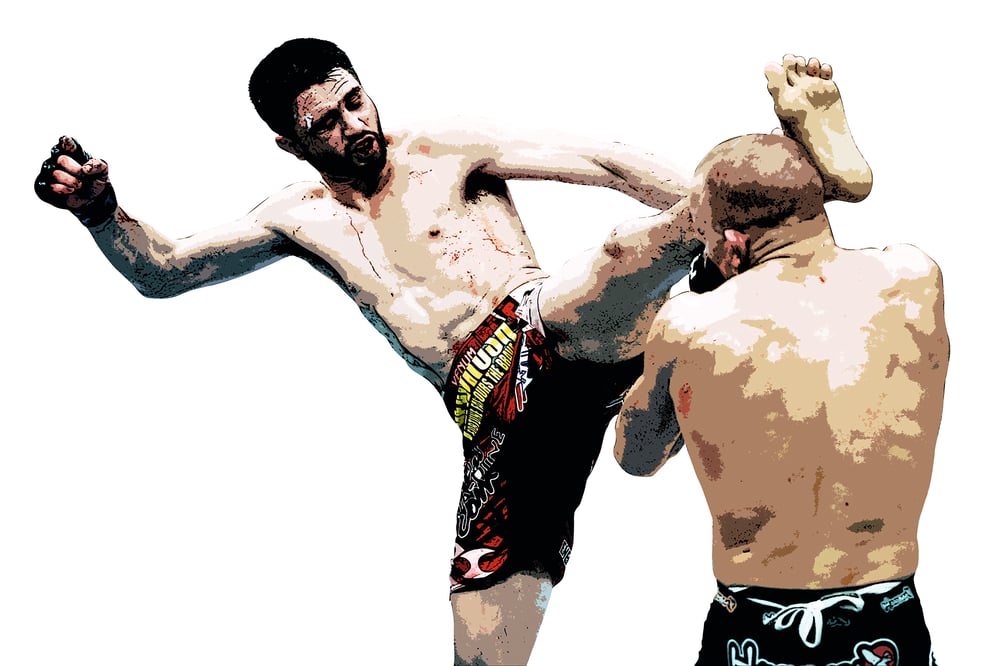
Issue 098
February 2013
How to choke out choking when you’re really up against it
Georges St Pierre silenced the skeptics at UFC 154 to become the greatest welterweight champion in MMA history by beating, as he put it, “the best guy I ever fought,” in Carlos Condit. GSP answered the one big question that has haunted his tenure as champion: does he possess the mental agility to overcome adversity when tested beyond his known limits?
Joe Bell
Chartered sport psychologist and one of few mental performance coaches specialising in combat sport, each issue he provides tips to improve your approach.
In the third round, St Pierre demonstrated his true grit by remaining calm and focused when he found himself on his back defending a wave of punches, courtesy of an earlier head kick from the challenger which tried to bury itself in the side of the champion’s temple.
When a fighter is under the intense kind of pressure Georges experienced, a number of things attack the psyche and physiology. When we get ‘rocked’ by a strike it triggers a primal in-built instinct where the mind automatically wants to tune into the ‘panic’ channel.
Breathing becomes erratic, which limits oxygen uptake, causing the heart rate to shoot up, and muscles to tense. This natural combination of side-effects causes many fighters to psychologically ‘choke’ (perform badly) and look for an out.
The reason GSP was able to override the instinctive drive to give up and persevere was because his sport psychology training kicked in. A huge supporter and ambassador of the mental game, St Pierre has a bag of psychological tricks at his disposal, and the one he pulled out in Montreal allowed him to remain centred and in the present, regardless of the chaos inside and outside the Octagon.
Back in the March 2012 issue, I ran FO readers through a similar method as a way of maintaining focus by controlling counterproductive thoughts using meditation as a way of silencing the mind when it wants to take hold.
However, in hindsight, I’ve found without hands-on guidance most fighters struggle with meditation due to lack of familiarity and the time it takes to master. To tackle this, try the following fighter-friendly psych technique. It’s quick to learn and easy to execute, and it’s the one GSP used at UFC 154.

Combative Centering
Originally developed by the Shaolin monks, today it is employed by open-minded combat sport athletes and Special Forces. It has both physical and mental components. Physically it involves finding your centre of gravity (COG), the place in your body where your weight is evenly distributed from front to back, side-to-side and top to bottom. Mentally it involves putting your mind into a state able to control stress, negative thoughts and block out distractions allowing the practitioner to refocus attention on task-relevant cues. Here’s how to weave it into a real fight:
Establish Centre of Gravity
If you find yourself trading strikes and you get dazed by a clean blow, as quick as you can, you must reset your body into a neutral stance (just slightly wider than shoulder-width apart for MMA). This should provide solid balance without sacrificing mobility. To confirm it feels right, with the correct weight displacement, bounce a few times on your toes, you’ll know if it doesn’t feel right. If you can’t scramble back to your feet, you ideally need to establish a closed-guard and tie your opponent up and tune into their COG, e.g. is it top heavy?
Breathe
Most psych techniques will always involve breathing, it helps us relax, but does very little else unless you know what to do after. Combative centering picks up where breathing leaves off. Draw breath deep from your abdomen and feel your neck and shoulder muscles loosen up as you inhale.
Connect with your COG
Exhale slowly and fully, now turn all your attention to your COG (or your opponent’s weight placement if you’re on the bottom) nothing else. If your focus is fixated on your COG, it can’t be anywhere else – not on your opponent’s actions, not on the voice inside your head, not on the crowd.
Tactical Reminder
As you finish your centering breath, narrow your focus to a place in your mind we call the ‘action’ channel. This is the single-most important reason as to why you are in the Octagon. Now it’s time to build in a tactical reminder that boils down the complexity of your answer into a short phrase or single word. This reminder is intended to bring you back from inside your mind and into the moment, and will allow you to focus on your performance.
Like any element of the physical game, if don’t you use it you lose it. The same goes for the mental game.










